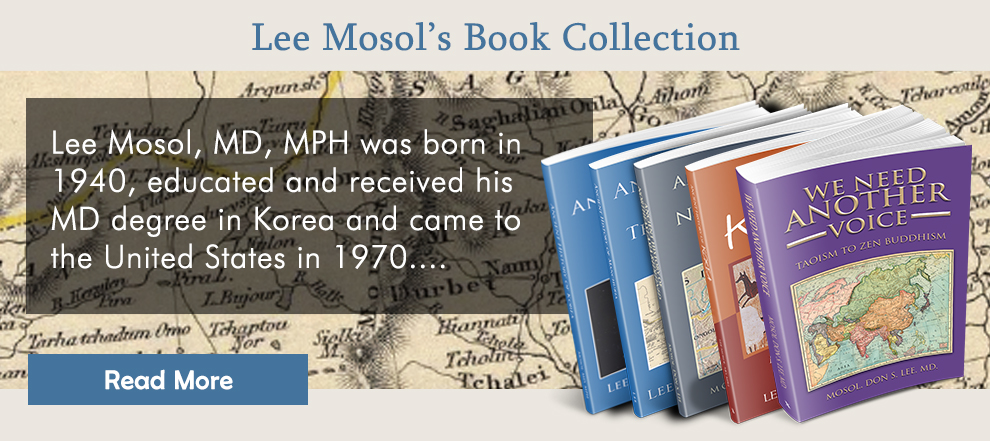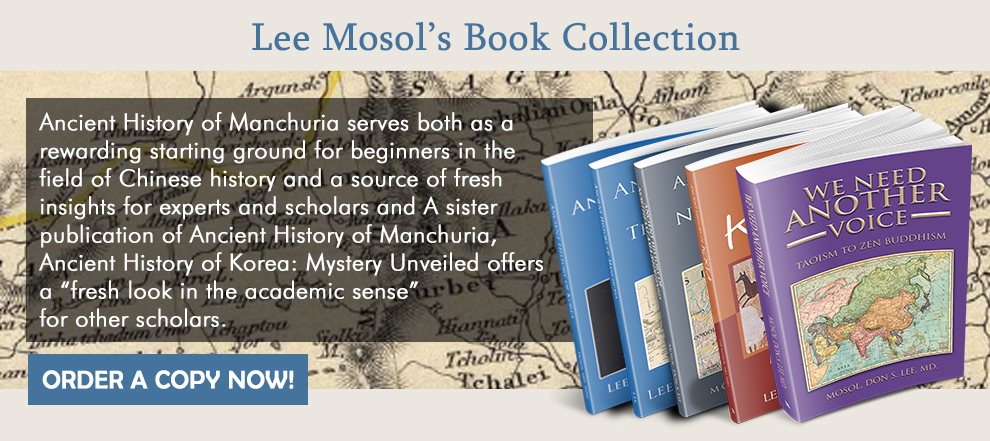Ancient History of Northeast Asia
Redefined
東北亞 古代史 新論
Mosol, Don S. Lee
In memory of my parents, who had suffered throughout their short live
Dedicated to my wife Jane and my children
Preface:
Good number of my acquaintances raises the question; why a medical doctor writes a historiography? My answer is still the same as I provided in the past couple of times.
This book couldn’t be published by anyone living in Manchuria or the Korean Peninsula.
Because geopolitical reason and unique Korean culture, none of historian in the Korean academic circle could envision the way I set the premises. Even today, the geopolitics works the same way as had been over two thousand years. It is the major dilemma for the scholars in the Korean peninsula to study of ancient History of Korea. Any historian who studied the Korean history would realize that whatever they have said before appears to be different, depending upon certain character or phrase being interpreted as a combination of PLCs or PSMCs come up with very different outcome. Studying the history of Northeast Asia is a process. As a result, my third book was necessary to correct mistakes that I have made in past two books.
In academic sense, it is very difficult to interpret the ancient Chinese ideogram. Without knowing the whole evolutionary process of the Chinese character and culture, it is impossible to provide clear and right explanation by one party. Yet, history of Northeast Asia is projected by the one side only. Whole world scholars accepted it as the final word. It needs to be explored by the other scholars. It is a huge subject. Readers’ interest could be variable depending upon their stance in academic world or society they live. For those reason I chose to make a two section; one in English and another in Korean language inserting lots of original logograms in the scriptures for the readers to compare to the work of other scholar.
The time, place, resources, and current social setting allow me to stand up and make an opposing view against traditional interpretation.
First, I am benefitting the freedom that founding father of this great nation provided to the future generation. Had I been living in the Northeast Asia, this writing wouldn’t be possible. Once again, I am grateful to the founding father of this great nation on earth, America. They promised the freedom of speech and left all of the law of nature as the law of the land. Without any fear, I am speaking what I believe in the truth being extrapolated through the ancient scriptures.
Second, without the current technical advancement, namely, Internet search through various Web sites such as Google, Baidu, and Yahoo, it would be impossible to get some rare old scriptures which Korean scholars couldn’t read in the past. I deeply appreciate the program developer, owner, and director of the Chinese Text Project (http://ctext.org/zh. 中國哲學書電子化計劃), Mr. Donald Sturgeon. Majority of the cited references came from his program. This essay contains lots of Chinese ideograms with different tones. Most of the phrase clause that needed to be quoted came from the Chinese Text Project. Pronunciation of logogram in different time and places were considered based upon the http://ctext.org/zh, 漢典, and Daum dictionary.
This essay is very unique historiography based upon new concept about the ancient history written by Chinese scholars under Confucian value. It is my argument that the ancient scriptures had been misinterpreted. I assert that English translation (accurate in tone, meaning and content) of any and all foreign-language text in the Book-1 is my personal view for academic discussion.
Bernie J Bae in St Paul Minneapolis designed the book cover. Dr. Unchul Lee who teaches Confucian classics in the Northern Virginia for several years provided important suggestion in English translation. SJ Kim in Korea and Michael Che-Kwang Ryoo in Queensland, Austria provided an idea for the maps. It is a multilingual text of two sections, mainly because two distinctive groups of people would interest on this subject with different stance. They could have different interpretation of Chinese logograms. Lastly, it is difficult for the publishing company for editing. I am glad that I met the right one, the Xlibris. I owe a debt of gratitude and appreciation to all of them.
Romanization of the names in the scripture:
Romanization of Chinese scriptures has been an issue for long time. Since modern era of scientific and technological advancement, the academic society made the guideline based upon the western pioneer of Far East Asia formulated the Romanization of foreign language. They have adopted a few versions, which are ignored by the current internet news and report as seen in the Google and Wikipedia. By studying Ancient history of Northeast Asia, it is apparent that the ancient Chinese scriptures compiled with lots of PLCs and PSMCs. Northerners spoken Tungusic language. Hence, good numbers of ancient logograms are still pronounced as Korean does. Also certain sentences were written with the current Korean syntax. For those reasons, author boldly adapted to Romanize good number of proper names in the scriptures primarily under the Korean way of pronunciation and considered Romanization in the Wikipedia as secondary.
Historiography dealing with vast territory and long time period, maps is very important for the readers to comprehend the textural message. To avoid many maps in the book, the following master map is edited from the Google map for the readers:
Though this essay titled as Redefined, study of Northeast Asian History is on going process. For those reason, the author set up the website to communicate other scholars: https://www.ancienthistoryofkorea.com/삼한-三韓의-후예-後裔들/
https://www.facebook.com/people/Mosol-Lee/100010115040138.
I assert that my manuscript contains an accurate English translation (accurate in tone, meaning and content) of any and all foreign-language text that is included in my manuscript.
June 21st 2018
Mosol, Don S. Lee. MD, MPH
McLean, Virginia, USA
Table of Contest (** Please adjust according to your best judgment on the naming of subsections. I will leave up to the publishing company)
Book One: English
Part One: Dawn of Civilization in the North Eastern Asia
Birth Place of Chinese civilization:
Unique nature of the Yellow River Civilization:
Birth Place of Wanggeom Joseon:
The mystical unicorn:
Epic flood control:
Birth of First King of the Kings
Hong-Shan culture sites:
Location and size of the Nine Provinces:
Four seas (四海) before the Grand historian:
The first map, Shan-Hai Ching (山海經):
We have heard only one side story:
Unique nature of Chinese character:
Chinese hermeneutics and syntax:
Ancient scriptures had been tempered:
Liùshū (六書) Fallacy:
Evolution of dictionaries:
Method of the North Eastern Asian history study:
Etymology of few words:
Dongyi (東夷) and Donghu (東胡):
Wuhuan(烏丸, 烏桓) and Xianbei(鮮卑);
Etymology of 高句麗, 夫餘:
Yae Maek(濊貊) people left Hongshan Culture:
Revolt of Nine Ryeo tribes(九黎之亂) is the Battle of Zhuolu:
Etymology of Bohai(渤海):
Boyi invented the Go (圍棋) game:
Part Two: Birth of Wanggeom Joseon.
Dangun Joseon, Gojoseon
Wu (禹), Boyi(伯益) and Yuxing (禹刑)
Discovery of the Bamboo Annals unveiled Mystery of Boyi(伯益):
Boyi(伯益) is the Dangun Wanggeom (壇君王儉):
Gojoseon moved the capital:
Shanxi people spoke the Tungusic language:
Gojoseon History in the Shijing:
Part Three: Gojoseon History in the House of Jin.
Logogram Jin (晉; 㬜; 臸,日) has meaning of Joseon
Modu(旄頭) and Modu (冒頓) is Korean word 모두:
Chinese logograms keep the history:
Discovery of the Bamboo Annals:
Tale of King Mu, Son of Heaven (穆天子傳):
Baljoseon(發朝鮮) and the feudal state Jin (晉):
Duke Mu of the Northern State(北州侯莫).
Southern Boundary of the Northern State:
Part Four: Gojoseon Divided
Goguryeo and Buyeo started from Shanxi Province:
Vagabond roamed over North China Plan:
Fallacy of General Qin Kai:
Baljoseon (發朝鮮)in the Northern China Plain
Manchu was the Far Away Paradise:
The Eastern End of Great Wall:
Metal currency of Gojoseon is the Ming Knife Money (明刀錢):
Etymology of Lelang (樂浪) and Daebang:
Etymology of Manchu (滿洲):
Etymology of Yiwulü Mountain (醫巫閭山):
Origin of king Bi (朝鮮王否):
Liaoning bronze dagger is the Gojoseon culture:
Hongshan culture is a part of Gojoseon culture.
Part Five: Manchuria. The Far Away Paradise
Brief History of the Manchuria:
Northern boundary of the feudal state Yan:
Baljoseon (發朝鮮) to Gyi Joseon (暨朝鮮):
Far Away Paradise, Land of Sage without Dictators:
Paradise to Hell:
Part Six: The Han (漢) Invasion and Birth of Three Hahn.
Radical Neo-Confucianism:
Reason of Han invasion:
location of King Ugeo Citadel(王險城)
History of Buyeo (夫餘) concealed:
Four Commanderies is Fallacy or poorly orchestrated Concert:
Two founding legends of Baekjae:
Yiwulü Mountain, Busan (富山), Xianbei Mountain:
Part Seven: Local Revolt(魏晋南北朝; 220-589CE)
Etymology of 烏丸and 鮮卑 is Fallacy:
Relationship of Dongyi chief Nam Lu, Balgi(發岐), SajaWeegudae, and Gongsun du:
Tenpō calendar(天保歷) in Japan:
Wei Queen Bimiho (倭女王卑弥呼):
Source of dispute about the Gwanggaeto Stele:
Part 8 Baekjae hold Imperial Seal:
Evidences of Continental Baekjae:
Confusing name of ruler and countries:
Reliability of historical information(史料):
Trail of the Imperial Seal
Part 9: North and East of Han Hae(翰海):
Goguryeo capital Chang’an Citadel(長安城)
Battle of Linyuguan (臨渝關) and Salsu River(薩水之戰):
Guya Hanguk (狗邪韓國) is the Han Citadel(漢城) of Baekjae
Silla from Manchuria to Korean peninsula:
Birth of Nihon Goku(日本國)
Mystery of the Seven-Branched Sword:
Demarcation of Period in NEA history:
Gojoseon revived as Khitan Empire.
Zen Buddhism(禪宗) originated from Taoism:
Book Two: Korean language. (*Attached Book 2 PDF)
It is author’s suggestion to the readers who wish to further explore the proposed theory.
Index: All the names of proper nouns under Chinese logogram in the text.
About the Author
Written by Lee Mosol
Retired physician from GWU and Georgetown University in 2010 2011: First Book in Korean "뿌리를 찾아서, Searching for the Root" 2013: Ancient History of the Manchuria. Redefining the Past. 2015: Ancient History of Korea. Mystery Unveiled.
Recent Posts
Recent Comments
- Don S. Lee MD on 부여의 시말:
- Seowa etymologist on Silla from Zhina(Southern China) to Korean Peninsula.
- James Kim on 약우 (若愚)
- James Kim on 약우 (若愚)
- James Kim on 약우 (若愚)
Archives
- January 2025
- November 2024
- May 2024
- February 2024
- October 2023
- August 2023
- June 2023
- May 2023
- March 2023
- February 2023
- January 2023
- August 2022
- July 2022
- April 2022
- March 2022
- January 2022
- December 2021
- November 2021
- October 2021
- September 2021
- August 2021
- July 2021
- June 2021
- March 2021
- February 2021
- January 2021
- December 2020
- November 2020
- October 2020
- September 2020
- May 2020
- April 2020
- March 2020
- February 2020
- January 2020
- December 2019
- November 2019
- October 2019
- September 2019
- August 2019
- July 2019
- June 2019
- May 2019
- April 2019
- February 2019
- January 2019
- December 2018
- November 2018
- October 2018
- September 2018
- July 2018
- March 2018
- February 2018
- December 2017
- November 2017
- October 2017
- September 2017
- August 2017
- July 2017
- June 2017
- May 2017
- April 2017
- March 2017
- February 2017
- January 2017
- December 2016
- November 2016
- October 2016
- September 2016
- August 2016
- July 2016
- June 2016
- May 2016
- October 2015
- September 2015
- July 2015
- May 2015
- April 2015
- November 2014



